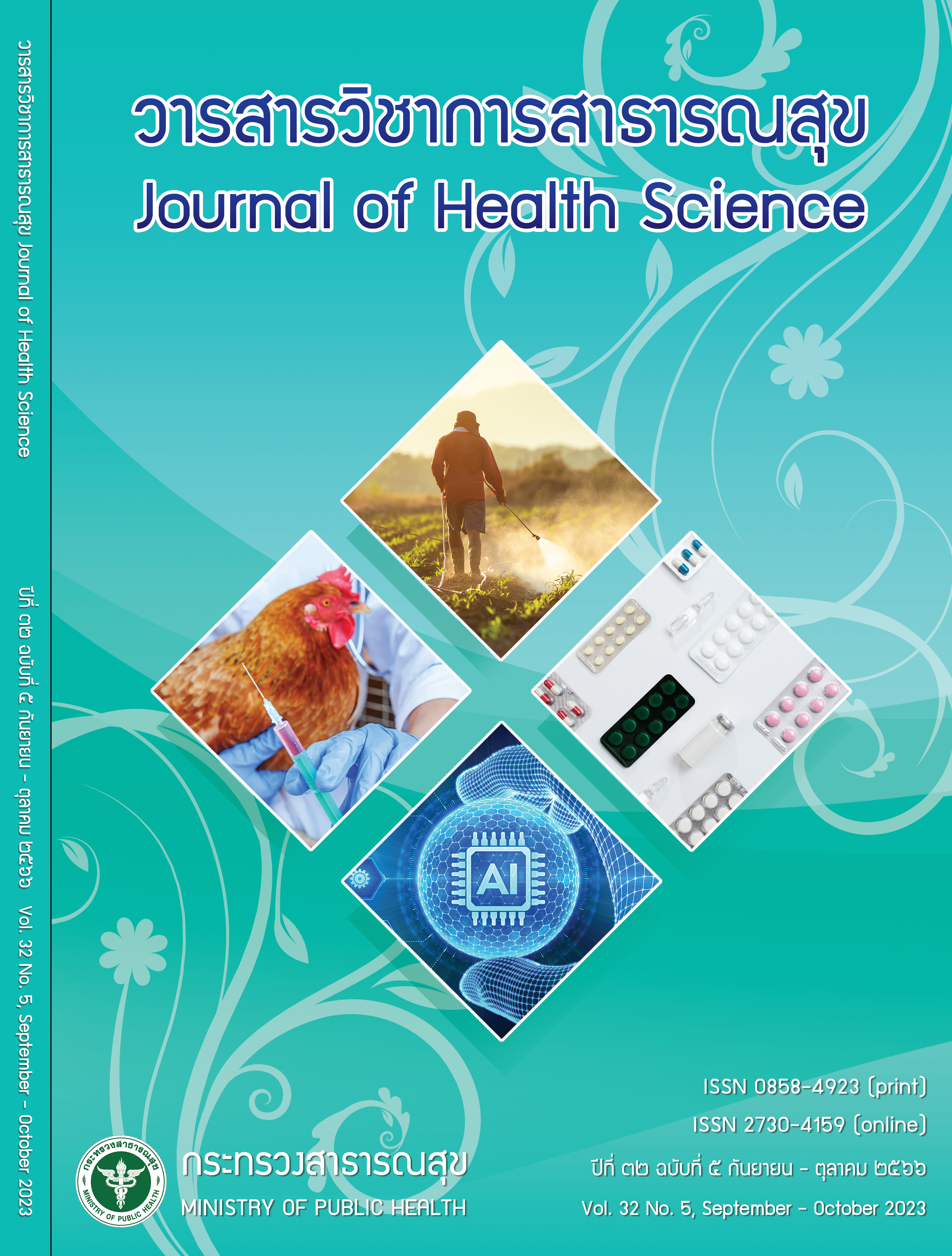Active surveillance of avian influenza virus in poultry in backyard farms, small-scale farms, and observation sites before exporting poultry for sale, and poultry carcasses in fresh markets in four border provinces of Thailand
Keywords:
active surveillance, avian influenza, poultry, border areasAbstract
Avian influenza outbreaks are still sporadic in neighboring countries. The central and local livestock and health sectors collaborated to create an active surveillance of avian influenza and a communication channel for exchanging avian influenza information obtained from the active surveillance. In addition, both sectors set guidelines for jointly investigating a disease if an avian influenza virus was reported in the border districts of Thailand adjacent to the Lao People’s Democratic Republic (Lao PDR). The surveillance areas were chosen in the six districts of four border provinces and the active surveillance was conducted from March 2018 to August 2021. The target populations for the active surveillance included (1) backyard poultry or small poultry farms, (2) poultry at observation sites before exporting poultry for sale at the border markets, and (3) poultry carcasses sold at fresh markets. Local livestock officers collected poultry samples every month. Five specimens/swabs were pooled in a tube containing viral transport media. Oropharyngeal swabs were collected from poultry at farms or backyards in six districts (approximate 360 specimens per month), and the observation sites before exporting poultry in two districts (approximate 30 specimens per month). Trachea specimens were collected from the fresh markets in six (approximate 60 specimens per month). All specimens were sent to the laboratories of the Department of Livestock Development and the Monitoring and Surveillance Center for Zoonotic Diseases in Wildlife and Exotic Animals laboratory, Faculty of Veterinary Science, Mahidol University for Avian Influenza diagnosis by chorioallantoic sac inoculation of embryonated chicken eggs and Real-time RTPCR. A total of 18,370 specimens collected from native chickens and ducks raised in backyards or on small-scale farms was negative to highly pathogenic avian influenza (HPAI) virus. Active longitudinal surveillance of poultry population in collaboration of public health and animal health sectors should be rigorously maintained to ensure the early detection of avian influenza virus, timely information sharing, and rapid and effective disease control and prevention.
Downloads
References
Tiensin T, Chaitaweesub P, Songserm T, Chaisingh A, Hoonsuwan W, Buranathai C, et al. Highly pathogenic avian influenza H5N1, Thailand, 2004. Emerg Infect Dis 2005;11(11):1664-72.
Department of Livestock Development, Thailand. Self-declaration of the recovery of freedom from highly pathogenic avian influenza (HPAI) by Thailand [Internet]. 2009 [cited 2022 Oct 18]. Available from: https:// www.woah.org/fileadmin/Home/eng/Publications_%26_Documentation/docs/pdf/bulletin/ENG_ Thailand_HPAI_2009.pdf
Food and Agriculture Organization of the United Nations. Global avian influenza viruses with zoonotic potential situation update [Internet]. 2023 [cited 2023 Apr 4]. Available from: https://www.fao.org/animal-health/ situation-updates/global-aiv-with-zoonotic-potential/ en
World Health Organization. Avian Influenza A (H5N1) – Cambodia [Internet]. 2023 [cited 2023 Apr 4]. Available from: https://www.who.int/emergencies/ disease-outbreak-news/item/2023-DON445
กรมปศุสัตว์ กระทรวงเกษตรและสหกรณ์. ฟาร์มที่มีระบบการป้องกันโรคและการเลี้ยงสัตว์ที่เหมาะสม [อินเทอร์เน็ต]. 2565 [สืบค้นเมื่อ 4 เม.ย. 2566]. แหล่งข้อมูล: https:// pvlo-pic.dld.go.th/th1/files/2561/GFM/ppt_GFM.pdf
Food and Agriculture Organization of the United Nations. Guiding principles for the design of avian influenza active surveillance in Asia [Internet]. 2564 [cited 2023 Apr 4]. Available from: https://www.fao.org/3/cc2005en/ cc2005en.pdf
World Health Organization. WHO information for the molecular detection of influenza viruses [Internet]. 2021 [cited 2023 Feb 16]. Available from: https://cdn.who. int/media/docs/default-source/influenza/molecular-detention-of-influenza-viruses/protocols_influenza_virus_detection_feb_2021.pdf?sfvrsn=df7d268a_5
Spackman E, Senne DA, Myers TJ, Bulaga LL, Garber LP, Perdue ML, et al. Development of a real-time reverse transcriptase PCR assay for type A influenza virus and the avian H5 and H7 hemagglutinin subtypes. J Clin Microbiol 2002;40(9):3256-60.
Monne I, Ormelli S, Salviato A, De Battisti C, Bettini F, Salomoni A, et al. Development and validation of a one-step real-time PCR assay for simultaneous detection of subtype H5, H7, and H9 avian influenza viruses. J Clin Microbiol 2008;46(5):1769-73.
Tsukamoto K, Ashizawa T, Nakanishi K, Kaji N, Suzuki K, Shishido M, et al. Use of reverse transcriptase PCR to subtype N1 to N9 neuraminidase genes of avian influenza viruses. J Clin Microbiol 2009;47(7):2301-3.
Hoffmann E, Stech J, Guan Y, Webster RG, Perez DR. Universal primer set for the full-length amplification of all influenza A viruses. Arch Virol. 2001;146(12):2275-89.
Centers for Disease Control and Prevention. EpiInfo [Internet]. 2018 [cited 2022 Oct 18]. Available from: http://wwwn.cdc.gov/epiinfo/html/prevVersion.htm
Oliveira GS, Silva-Flannery L, Silva JF, Siza C, Esteves RJ, Marston BJ, et al. Active surveillance and early detection of community transmission of SARS-CoV-2 Mu variant (B.1.621) in the Brazilian Amazon. J Med Virol 2022;94(7):3410-5.
Zhang JL, Chen ZY, Lin SL, King CC, Chen CC, Chen PS. Airborne avian influenza virus in ambient air in the winter habitats of migratory birds. Environ Sci Technol 2022;15;56:22.
Singh M, Toribio JA, Scott AB, Groves P, Barnes B, Glass K, et al. Assessing the probability of introduction and spread of avian influenza (AI) virus in commercial Australian poultry operations using an expert opinion elicitation. PLoS One 2018;13(3):e0193730.
Sengkeopraseuth B, Co KC, Leuangvilay P, Mott JA, Khomgsamphanh B, Somoulay V, et al. First human infection of avian influenza A(H5N6) virus reported in Lao People’s Democratic Republic, February-March 2021. Influenza Other Respir Viruses 2022;16(2):181-5.
Outbreak News Today. Laos reports two H5N1 avian influenza poultry outbreaks, WHO follow-up on human case [Internet] 2020 [cited 2033 Apr 18]. Available from: https://outbreaknewstoday.com/laos-reportstwo-h5n1-avian-influenza-poultry-outbreaks-whofollow-up-on-human-case-25819/
Peacock TP, James J, Sealy JE, Iqbal M. A Global Perspective on H9N2 Avian Influenza Virus. Viruses 2019; 11(7):620.
Peiris M, Yuen KY, Leung CW, Chan KH, Ip PL, Lai RW, et al. Human infection with influenza H9N2. Lancet 1999;354:916–7.
Butt KM, Smith GJ, Chen H, Zhang LJ, Leung YH, Xu KM, et al. Human infection with an avian H9N2 influenza A virus in Hong Kong in 2003. J Clin Microbiol 2005;43(11):5760-7.
Um S, Siegers JY, Sar B, Chin S, Patel S, Bunnary S, et al. Human infection with avian influenza A(H9N2) virus, Cambodia, February 2021. Emerg Infect Dis 2021; 27(10):2742-5.
นัตฏิยา ศรีสุราช, ศศิประภา วัฒนวิเศษ, พรรณิชา วงศ์สาย เชื้อ. ประเมินการตรวจหาเชื้อ SARS-CoV-2 จากตัวอย่างรวมด้วยวิธี Real Time RT-PCR ในจังหวัดขอนแก่น. วารสารเทคนิคการแพทย์ 2564;49(3):7910-21.
Downloads
Published
How to Cite
Issue
Section
License

This work is licensed under a Creative Commons Attribution-NonCommercial-NoDerivatives 4.0 International License.







